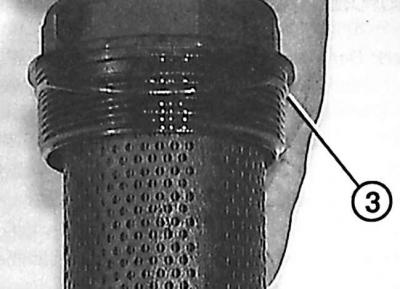Oil drain plug location

Periodic oil and oil filter changes are the most important preventive maintenance procedure. As engine oil ages, it becomes thin and contaminated, leading to premature engine wear.
Before starting this procedure, gather together all the necessary tools and materials. It is necessary that the engine be warm in order for the oil to drain better along with the bulk of the contaminants.
Order of execution
1. Raise the car on a lift or place the car in a horizontal position above the inspection hole.
2. Remove the lower engine mudguard.
3. Loosen the drain plug about half a turn. Place an oil drain container under the drain plug and unscrew the plug completely. If necessary, press the plug when unscrewing to prevent the oil from leaking prematurely, see fig. Oil drain plug location.
4. When the oil is completely drained, wipe everything around the drain hole with a rag and screw the plug securely into place.
5. Move the container under the oil filter.
4- and 6-cylinder engines
Location of the oil filter on 4- and 6-cylinder engines

Order of execution
1. Use the HAZET special tool 2171-1 to loosen the oil filter, then unscrew it by hand.
2. Wipe off all traces of oil and dirt around the filter attachment. Check if the rubber seal is left on the cylinder block. If it remains, then remove it.
3. Lubricate the rubber seal of the new oil filter with clean engine oil and screw in the oil filter by hand until the rubber gasket touches the engine, then tighten the filter by hand 1/2 turn.
5-cylinder engines
Lower part of the oil filter

- 1 - cork,
- 2 - hexagon,
- 3 - lower part of the oil filter,
- 4 - polyhedron
The drain plug in the oil filter is located on the side of the oil pan.
The location of the sealing ring at the bottom of the filter

- 3 - lower part of the oil filter
Location of the oil filler cap

Oil level on the dipstick

- a - minimum,
- b - normal,
- c - maximum
The location of the MAX and MIN·marks on the dipstick for measuring the oil level

Order of execution
1. For a hexagon or polygon, unscrew the bottom of the filter, see fig. Lower part of the oil filter).
2. Using a clean rag, remove the bottom of the filter with the filter cartridge.
3. Install a new filter cartridge.
4. Replace the O-ring at the bottom of the filter, see fig. The location of the sealing ring at the bottom of the filter.
5. Screw in the lower part of the filter with a force of 25 Nm.
6. Using tool N02-0135, screw the plug into the bottom of the oil filter with a torque of 10 Nm.
7. Remove the oil filler cap, see fig. Location of the oil filler cap.
8. Fill the engine with oil using the correct grade of oil. Fill in half of the required amount of oil and wait a few minutes for the oil to drain into the sump, then continue to add oil in small portions until the oil level reaches the maximum level on the dipstick (c), see fig. Oil level on the dipstick.
If the oil level is at the minimum level (a), adding approximately one liter more oil level will rise to the maximum level on the dipstick.
9. Close the filler cap.
10. Start the engine and let it run for a few minutes. Check it for oil leaks around the filter and drain plug on the pan. Keep in mind that the oil pressure warning light may be on for several seconds as the oil must fill all channels and oil reservoirs in the engine.
11. Stop the engine and wait a few minutes for the oil to drain into the sump. Check the oil level and top up if necessary. Check the tightness of the oil drain plug.
12. Install the lower engine mudguard.

Visitor comments